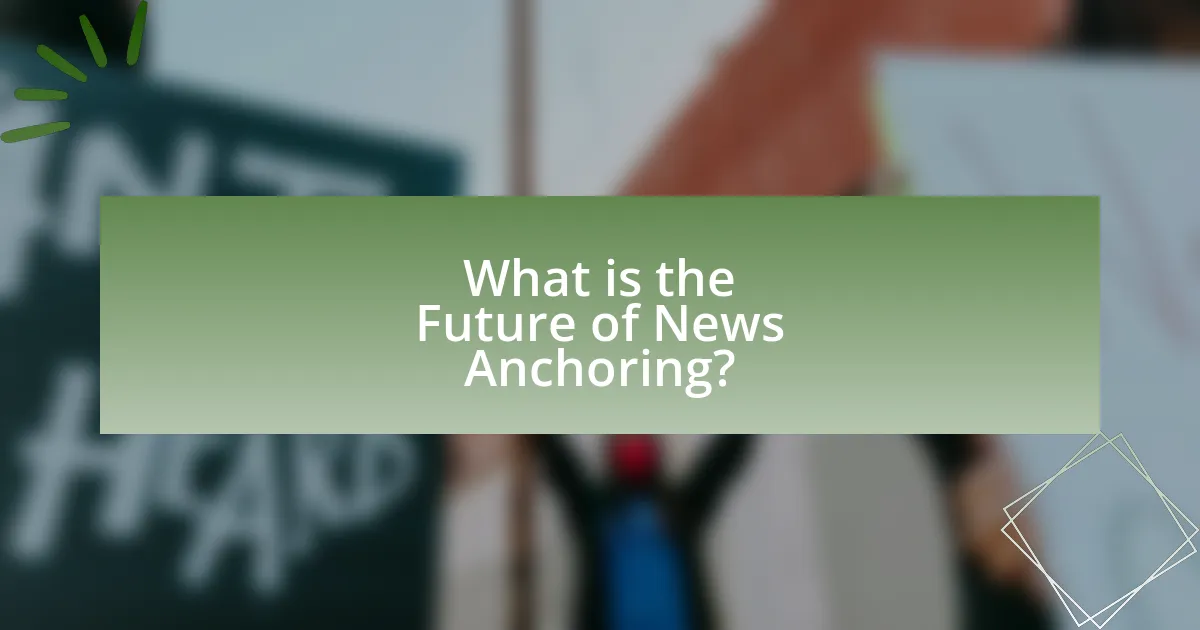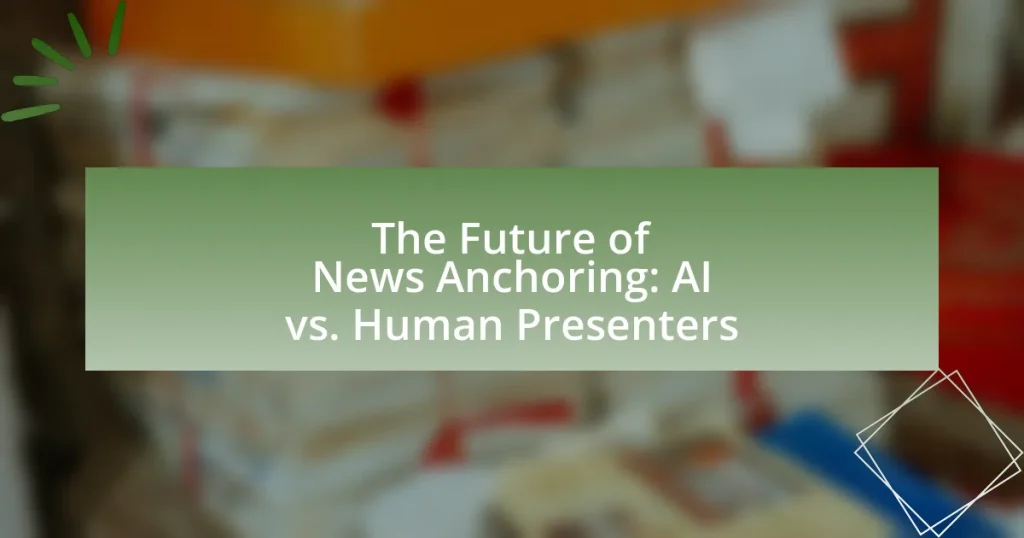The article examines the evolving landscape of news anchoring, focusing on the integration of artificial intelligence (AI) with human presenters. It highlights how AI technologies are enhancing news delivery through automation, real-time updates, and personalized content, while emphasizing the irreplaceable qualities of human anchors, such as emotional intelligence and credibility. The discussion includes the impact of technology on audience engagement, the challenges faced by both AI and human presenters, and the ethical considerations surrounding AI in journalism. Current trends and future strategies for news organizations are also explored, underscoring the necessity of a hybrid model that combines the strengths of both AI and human interaction in news presentation.

What is the Future of News Anchoring?
The future of news anchoring is increasingly leaning towards the integration of artificial intelligence alongside human presenters. AI technologies are being developed to automate news delivery, analyze data, and personalize content for viewers, which enhances efficiency and engagement. For instance, AI-generated news segments can provide real-time updates and cater to specific audience preferences, as seen in platforms like Reuters and Bloomberg that utilize AI for news curation. However, human anchors remain essential for delivering nuanced storytelling, emotional connection, and credibility, which AI currently cannot replicate. The combination of AI’s capabilities and human insight is likely to shape a hybrid model of news anchoring, balancing speed and personalization with the depth and trustworthiness that audiences expect.
How is technology influencing news anchoring?
Technology is significantly influencing news anchoring by enabling the integration of artificial intelligence and automation in news presentation. AI-driven tools can analyze vast amounts of data to generate news scripts, allowing for faster news delivery and real-time updates. For instance, companies like Associated Press utilize AI to produce thousands of earnings reports automatically, demonstrating the efficiency of technology in content creation. Additionally, virtual news anchors, such as those developed by Xinhua News Agency, showcase how technology can create lifelike presenters that operate 24/7 without human intervention. This shift not only enhances the speed and efficiency of news delivery but also raises questions about the future role of human anchors in an increasingly automated landscape.
What role does AI play in modern news presentation?
AI plays a significant role in modern news presentation by automating content generation, enhancing personalization, and improving audience engagement. For instance, AI algorithms analyze vast amounts of data to create news articles quickly, allowing news organizations to deliver timely updates. Additionally, AI-driven tools personalize news feeds based on user preferences, increasing relevance and engagement. According to a 2021 report by the Reuters Institute for the Study of Journalism, 58% of news organizations are using AI to assist in content creation and distribution, demonstrating its growing influence in the industry.
How are human presenters adapting to technological changes?
Human presenters are adapting to technological changes by integrating digital tools and platforms into their presentation styles. This adaptation includes utilizing social media for audience engagement, employing data analytics to tailor content, and incorporating multimedia elements to enhance storytelling. For instance, a study by the Pew Research Center in 2021 found that 73% of news organizations reported using social media to reach audiences, demonstrating a shift in how presenters connect with viewers. Additionally, presenters are increasingly using virtual reality and augmented reality technologies to create immersive experiences, which has been shown to improve viewer retention and engagement.
Why is the debate between AI and human presenters significant?
The debate between AI and human presenters is significant because it raises critical questions about authenticity, trust, and the future of journalism. As AI technology advances, its ability to deliver news with speed and efficiency challenges the traditional role of human presenters, who bring emotional intelligence and relatability to their reporting. Research indicates that 70% of audiences prefer human presenters for their perceived credibility and connection, highlighting the importance of human touch in news delivery. This debate impacts not only audience engagement but also ethical considerations in media, shaping the future landscape of news anchoring.
What are the advantages of AI news presenters?
AI news presenters offer several advantages, including increased efficiency, consistency, and the ability to process vast amounts of data quickly. These presenters can deliver news updates 24/7 without fatigue, ensuring that information is disseminated promptly. Additionally, AI can analyze trends and audience preferences to tailor content, enhancing viewer engagement. For instance, a study by the Reuters Institute for the Study of Journalism highlights that AI can generate news articles in seconds, significantly reducing production time compared to human journalists. This capability allows news organizations to keep up with the fast-paced news cycle and meet audience demands effectively.
What unique qualities do human presenters bring to news anchoring?
Human presenters bring emotional intelligence, authenticity, and adaptability to news anchoring. Emotional intelligence allows them to connect with viewers on a personal level, conveying empathy and understanding during sensitive news stories. Authenticity enhances trust, as audiences are more likely to engage with presenters who exhibit genuine reactions and relatable personalities. Adaptability enables human presenters to respond effectively to breaking news and unexpected situations, showcasing their ability to think on their feet. These qualities are supported by studies indicating that viewers prefer human interaction for complex emotional narratives, reinforcing the importance of human presence in news delivery.

What are the current trends in news anchoring?
Current trends in news anchoring include the increasing integration of artificial intelligence and automation in news presentation, as well as a growing emphasis on personalization and audience engagement. AI technologies are being utilized to generate news scripts, analyze viewer preferences, and even create virtual news anchors, which enhances efficiency and reduces operational costs. Additionally, news organizations are focusing on interactive formats, such as live streaming and social media integration, to foster real-time audience interaction and feedback. These trends reflect a shift towards a more dynamic and responsive news delivery model, catering to the evolving preferences of viewers in the digital age.
How are news organizations integrating AI into their operations?
News organizations are integrating AI into their operations by utilizing automated content generation, data analysis, and personalized news delivery systems. For instance, AI algorithms can generate news articles based on data inputs, allowing for rapid reporting on events such as sports scores or financial updates. Additionally, AI tools analyze audience preferences and engagement metrics to tailor news content to individual users, enhancing user experience and retention. A notable example is the Associated Press, which employs AI to produce thousands of earnings reports, demonstrating efficiency and scalability in news production.
What technologies are being used to enhance news delivery?
Artificial intelligence, machine learning, augmented reality, and mobile applications are technologies being used to enhance news delivery. AI algorithms analyze viewer preferences to personalize content, while machine learning improves the accuracy of news recommendations. Augmented reality provides immersive experiences, allowing viewers to engage with news stories interactively. Mobile applications facilitate real-time updates and notifications, ensuring that users receive the latest information promptly. These technologies collectively improve user engagement and accessibility in news delivery.
How is audience engagement changing with AI news anchors?
Audience engagement is changing with AI news anchors by increasing interactivity and personalization. AI news anchors utilize algorithms to analyze viewer preferences and tailor content accordingly, leading to a more engaging experience. For instance, a study by the Reuters Institute for the Study of Journalism found that 63% of respondents preferred news that was customized to their interests, which AI can efficiently provide. Additionally, AI anchors can operate 24/7, allowing for real-time updates and immediate responses to breaking news, further enhancing viewer engagement.
What challenges do AI and human presenters face?
AI and human presenters face challenges related to audience engagement, credibility, and adaptability. AI presenters struggle with emotional intelligence and nuanced communication, which can hinder their ability to connect with viewers on a personal level. Human presenters, while adept at conveying emotion and building rapport, may face issues such as bias, fatigue, and the need for continuous training to keep up with technological advancements. Research indicates that 70% of viewers prefer human presenters for their perceived authenticity, highlighting the importance of human connection in news delivery. Conversely, AI can process vast amounts of data quickly, but lacks the ability to interpret complex social cues, which can lead to miscommunication.
What ethical concerns arise from using AI in news anchoring?
The ethical concerns arising from using AI in news anchoring include misinformation, lack of accountability, and potential bias. Misinformation can occur when AI-generated content lacks the context or nuance that human journalists provide, leading to the dissemination of false or misleading information. Lack of accountability arises because it is difficult to attribute responsibility for errors or unethical behavior to an AI system, unlike human anchors who can be held accountable for their actions. Additionally, AI systems may perpetuate existing biases present in their training data, resulting in skewed reporting that does not accurately represent diverse perspectives. These concerns highlight the need for careful consideration and regulation of AI technologies in journalism.
How do human presenters compete with AI in terms of credibility?
Human presenters compete with AI in terms of credibility by leveraging emotional intelligence, personal experience, and authenticity. Unlike AI, which relies on data and algorithms, human presenters can connect with audiences on an emotional level, fostering trust through relatable storytelling and genuine expressions. Research indicates that audiences often perceive human presenters as more trustworthy due to their ability to convey empathy and understanding, which AI lacks. For instance, a study published in the Journal of Communication found that viewers rated human news anchors higher in credibility compared to AI-generated news, highlighting the importance of human connection in media.

What does the future hold for news anchoring?
The future of news anchoring will increasingly involve the integration of artificial intelligence alongside human presenters. AI technologies are advancing rapidly, enabling automated news generation and personalized content delivery, which can enhance viewer engagement and efficiency. For instance, AI can analyze vast amounts of data to produce real-time news updates, as seen in platforms like Reuters and Associated Press, which utilize AI for generating news articles. However, human anchors will continue to play a crucial role in providing context, emotional connection, and credibility that AI cannot replicate. This hybrid model suggests that while AI will augment news delivery, the human element will remain essential for nuanced storytelling and audience trust.
How might AI evolve in the field of news presentation?
AI might evolve in the field of news presentation by enhancing personalization and automating content generation. As AI algorithms become more sophisticated, they will analyze viewer preferences and behaviors to deliver tailored news experiences, ensuring that content is relevant to individual audiences. For instance, AI can utilize natural language processing to summarize articles and generate real-time news updates, which has already been demonstrated by platforms like Associated Press, where AI generates thousands of earnings reports automatically. Furthermore, advancements in deep learning could lead to more realistic virtual news anchors, as seen in projects like China’s Xinhua News Agency’s AI news presenter, which combines AI-generated scripts with lifelike avatars. These developments indicate a significant shift towards AI-driven news delivery, improving efficiency and engagement in the news industry.
What advancements in AI could impact news delivery?
Advancements in AI that could impact news delivery include natural language processing, automated content generation, and personalized news curation. Natural language processing enables AI systems to understand and generate human-like text, allowing for real-time news updates and summaries. Automated content generation tools, such as those developed by OpenAI, can produce articles and reports quickly, enhancing the speed of news dissemination. Personalized news curation algorithms analyze user preferences and behaviors to deliver tailored news feeds, improving user engagement. These advancements are supported by the increasing capabilities of AI models, which have shown significant improvements in language understanding and generation, as evidenced by the performance of models like GPT-3 in various language tasks.
How might audience preferences shape the future of news anchoring?
Audience preferences will significantly shape the future of news anchoring by driving the demand for personalized and engaging content. As viewers increasingly favor interactive and on-demand news formats, broadcasters will adapt by integrating technology, such as AI, to tailor news delivery to individual tastes. For instance, a study by the Pew Research Center in 2021 found that 64% of Americans prefer news that aligns with their interests, indicating a shift towards customization in news consumption. This trend suggests that news organizations will prioritize audience feedback and analytics to refine their anchoring styles, potentially leading to a blend of human and AI presenters that cater to diverse viewer preferences.
What strategies can news organizations adopt for the future?
News organizations can adopt strategies such as integrating artificial intelligence for content curation and enhancing audience engagement through personalized news delivery. By leveraging AI technologies, news organizations can analyze viewer preferences and optimize content distribution, leading to increased viewer retention. For instance, a study by the Reuters Institute for the Study of Journalism found that 63% of respondents prefer personalized news feeds, indicating a demand for tailored content. Additionally, investing in multimedia storytelling and interactive formats can attract younger audiences, as research shows that 70% of millennials prefer video content over text. These strategies position news organizations to remain relevant and competitive in a rapidly evolving media landscape.
How can human presenters leverage technology to enhance their roles?
Human presenters can leverage technology by utilizing advanced tools such as teleprompters, augmented reality, and data analytics to enhance their delivery and engagement. Teleprompters allow for smooth and confident presentations, while augmented reality can create immersive experiences that captivate audiences. Data analytics provides insights into viewer preferences and engagement metrics, enabling presenters to tailor their content effectively. For instance, a study by the Pew Research Center found that 73% of viewers prefer news delivered with interactive elements, highlighting the importance of technology in modern news presentation.
What best practices should be followed in integrating AI with human presenters?
Best practices for integrating AI with human presenters include ensuring seamless collaboration, maintaining transparency, and enhancing audience engagement. Seamless collaboration can be achieved by designing AI systems that complement human skills, such as providing real-time data analysis or generating content suggestions. Transparency is crucial; audiences should be informed when AI is involved in content creation or presentation, fostering trust. Enhancing audience engagement involves using AI to personalize content delivery based on viewer preferences, which has been shown to increase viewer retention and satisfaction. For instance, a study by the Pew Research Center found that personalized content can lead to a 30% increase in audience engagement.
What practical tips can help navigate the future of news anchoring?
To navigate the future of news anchoring, professionals should embrace technological advancements, enhance digital literacy, and focus on audience engagement. Adapting to AI tools can streamline news production and improve content delivery, as seen in organizations that have integrated AI for data analysis and content generation. Additionally, developing skills in multimedia storytelling and social media platforms is crucial, as research indicates that audience preferences are shifting towards interactive and visually engaging formats. Finally, fostering a strong personal brand and maintaining authenticity will help human presenters differentiate themselves in an increasingly automated landscape.




